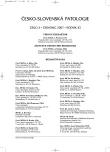Neuropathology of the Glioneuronal Lesions of the Brain Associated with Pharmacoresistant Epilepsy
Neuropatologie glioneuronálních lézí mozku spojených s farmakorezistentní epilepsií
Glioneuronální léze mozku (glioneuronální nádory a malformace) jsou po skleróze hipokampu druhou nejčastější příčinou farmakorezistentní epilepsie, diagnostikovanou biopticky v mozkové tkáni v rámci epileptochirurgických výkonů. Ve sdělení shrnujeme naše dosavadní zkušenosti s diagnostikou a klasifikací těchto poruch a diskutujeme výsledky studií molekulárních mechanismů rozvoje epilepsie u těchto poruch.
Klíčová slova:
epilepsie – malformace mozku – kortikální dysplazie – gangliogliom – dysembryoplastický neuroepiteliální tumor
Authors:
J. Zámečník
Authors‘ workplace:
Ústav patologie a molekulární medicíny, 2. LF UK a FN Motol, Praha
Published in:
Čes.-slov. Patol., 43, 2007, No. 3, p. 79-85
Category:
Reviews Article
Overview
Besides the hippocampal sclerosis, the glioneuronal lesions of the brain (glioneuronal tumors and malformations) represent the second large cohort of patients with intractable epilepsy diagnosed in the epileptosurgical specimens. Our experience with diagnosis and classification of the glioneuronal disorders are reported. Current research efforts, enabled by the availability of a well-characterized human biopsy material, have addressed the issue whether these lesions play an active role in the onset of epileptic seizures. The results of those studies are discussed in the review as well.
Key words:
epilepsy – brain malformations – cortical dysplasia – ganglioglioma – dysembryoplastic neuroepithelial tumor
Labels
Anatomical pathology Forensic medical examiner ToxicologyArticle was published in
Czecho-Slovak Pathology

2007 Issue 3
Most read in this issue
- The Autopsy of Reinhard Heydrich
- Expression of E-cadherin and c-erbB-2/HER-2/neu Oncoprotein in High-Grade Breast Cancer
- Pleomorphic Epithelioid/Clear Cell Malignant Tumor of the Uterus Exhibiting both Myoid and Melanocytic Differentiation – Leiomyosarcoma or PEComa? A Case Report and a Review of the Literature
- Bloch-Sulzberg Syndrome in Pathology
